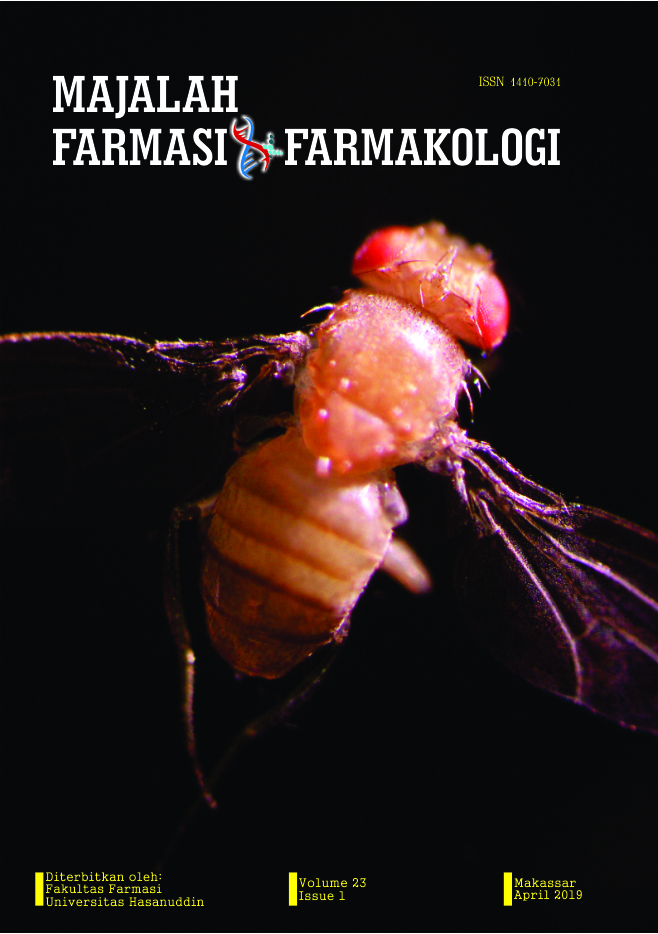IDENTIFIKASI GENOTIP CTX-M PADA Escherichia coli PENGHASIL EXTENDED SPECTRUM BETA LACTAMASE (ESBL) YANG RESISTEN PADA CEPHALOSPORIN GENERASI III DI RSUP WAHIDIN SUDIROHUSODO MAKASSAR
Abstract
Penelitian ini bertujuan untuk mengetahui untuk mendaptkan gambaran tentang prevalensi kejadian Escherichia coli penghasil ESBL yang resisten terhadap cephalosporin generasi III pada pasien RSUP Dr. Wahidin Sudirohusodo Makassar dan prevalensi genotif CTX-M Escherichia coli penghasil ESBL yang resisten terhadap cephalosporin generasi III pada pasien RSUP Dr. Wahidin Sudirohusodo Makassar. Penelitian dilaksanakan diruang perawatab rawat inap, ruang ICU, ruang HCU, ruang PICU, ruang IGD anak, Infection Center, laboratorium patologi klinik RSUP Dr. Wahidin Sudirohusodo dan laboratorium mikrobiologi klinik RSP Universitas Hasanuddin Makassar periode Juni 2018 – Agustus 2018. Penelitian ini menggunakan desain eksperimental laboratorium dengan teknik pengambilan sampel secara consecutive sampling. Bakteri Escherichia coli diisolasi dari 50 pasien. Pengujian dilakukan meliputi uji sensitivitas antibiotika dengan mengunakan metode difusi agar Kirby-bauer dan vitek 2 compact, uji deteksi ESBL dengan metode Double Disc Synergy Test (DDST), Phenotypic Confirmatory Test dan Uji genotip CTX-M Polymerase Chain Reaction (PCR). Hasil penelitian menunjukkan uji sensitivitas antibiotika pada 50 sampel klinik (Urin, Sputum, Darah, Feses, Pus dan Jaringan) yang diuji terhadap antibiotika golongan sefalosporin generasi III yang telah mengalami resistensi sebesar 40 isolat (80%) baik pada Ceftriaxone, Cefotaxime dan Ceftazidine. Pada uji fenotip dengan metode DDST dan Vitek 2 compact ditemukan 40 sampel (80%) positif ESBL pada Antibiotika Cefotaxime+As.Klavulanat (30 ųg/10 ųg ) maupun Ceftazidine+As.Klavulanat (30 ųg/10 ųg ). Pada uji genotip CTX-M di temukan 41 sampel (82%) memiliki gen CTX-M penghasil ESBLReferences
Carter GR, Wise DJ. 2004. Essential of Veterinary Bacteriology and Mycology. 6th Ed. Iowa : Blackwell Publishing.
Branger Catherine et. Al., 2018, Extended-spectrum β-lactamase-encoding genes are spreading on a wide range of Escherichia coli plasmids existing prior to the use of third-generation cephalosporins, Microbial Genomics 2018;4
Bradford,P.A.(2001).Extended-spectrum beta-lactamases in the 21stcentury: characterization, epidemiology, and detection of this important resistance threat. Clin.Microbiol.Rev. 14,933–951.doi:10.1128/CMR.14.4.933-951.2001
Gutkind, G. O., Di Conza, J., Power, P., and Radice, M. (2013). beta-lactamase mediated resistance: a biochemical, epidemiological and genetic overview. Curr. Pharm. Des. 19, 164–208. doi: 10.2174/1381612811306020164
Paterson, D.L., Bonomo, R.A. 2005. Extended-Spectrum Beta-Lactamases: A Clinical Update. Clin Microbiol Rev. 18(4):657-86.
Al-Agamy MH, Shibl AM, Tawfik AF. Prevalence and molecular characterization of extended-spectrum beta-lactamase-producing Klebsiella pneumoniae in Riyadh, Saudi Arabia. Ann Saudi Med.2009;29(4):253–7.
Munier GK, Johnson CL, Snyder JW, Moland ES, Hanson ND, Thomson KS. 2010, Positive extended-spectrum-beta-lactamase (ESBL) screening results may be due to AmpC beta-lactamases more often than to ESBLs. J Clin Microbiol. 48(2)
Bush K, 2010, Alarming beta lactamase-mediated resistance in multidrug resistant Enterobacteriaceae. Current Opinion in Microbiology (13). Elsevier; 558-564
Bonnet R., 2004, Growing group of extended-spectrum beta-lactamases: the CTX-M enzymes. Antimicrob Agents Chemother.;48(1):1–14.
Edelstein M, Pimkin M, Palagin I, Edelstein I, Stratchounski L., 2003, Prevalence and molecular epidemiology of CTX-M extendedspectrum beta-lactamase-producing Escherichia coli and Klebsiella pneumoniae in Russian hospitals. Antimicrob Agents Chemother; 47(12):3724–32
Wang, P., Hu, F., Xiong, Z., Ye, X., Zhu, D., et al. 2011. Susceptibility of Extended Spectrum Beta Lactamase Producing Enterobacteriaceae According to the New CLSI Breakpoints. J Clin Microbiol. 49(9):3127-31
Shaik, S., Fatima, J., Shakil, S., Rizvi, M.D., et al. 2015. Antibiotic Resistance and Extended Spectrum Beta-Lactamases: Types, Epidemiology and Treatment. Saudi Journal of Biological Sciences. 22, 90-101.
Kuper, K.M., Boles, D.M., Mohr, J.F., Wanger, A., 2009. Antimicrobial susceptibility testing: primer for clinicians. Pharmacotherapy 29 (11), 1326–1343
Pincus David H., 2006, Microbial Identification Using The Biomérieux Vitek® 2 System, Encyclopedia of Rapid Microbiological Methods, bioMérieux, Inc. Hazelwood, MO, USA
Karowsky J A. et. al. 2010. Multidrug resistant urinary tract isolates of Escherichia coli : prevalence and patient demographics in the United states in 2009. Antimicrob Agents Chemother; 45(5) : 1402-06.
Hanna E Sidjabat , David L Paterson,. 2015, Multidrug-resistant Escherichia coli in Asia: epidemiology and management, UQ Centre for Clinical Research The University of Queensland, ISSN 1478-7210 Queensland
Smyth EG, O'Connell N .2004. Complicated urinary tract infection. Drugs & Therapy Perspectives; 11(1): 63-6.
Prihatini, Aryati, Hetty., 2007, Identifikasi Cepat Mikroorganisme Menggunakan Alat Vitek-2 Compact, Indonesian Journal of Clinical Pathology and Medical Laboratory, Vol. 13, No. 3 : 29-132 Airlangga University Press,Surabaya
Kementerian Kesehatan RI. 2012. Tentang Pedoman Umum Penggunaan Antibiotika. Depkes RI : Jakarta
World Health Organization (WHO). 2014. Antimicrobial Resistance: Global Report on Surveillance 2014.
Kuntaman Kuntaman, Sanarto Santoso, Hendro Wahjono, Ni Made Mertaniasih, Endang S. Lestari, Helmia Farida, Rebriarina Hapsari, Stefani Candra Firmanti, Noorhamdani AS, Dewi Santosaningsih, Priyo Budi Purwono, Deby Kusumaningrum, 2010, The sensitivity pattern of extended spectrum beta lactamase producing bacteria against six antibiotics that routinely used in clinical setting, Journal Indonesian Medical Association Volume: 61, Nomor: 12
Severin Julie¨tte A., Ni Made Mertaniasih, Kuntaman Kuntaman, Endang S. Lestari, Marijam Purwanta, Nicole Lemmens-Den Toom, D. Offra Duerink, Usman Hadi, Alex van Belkum, Henri A. Verbrugh and Wil H. Goessens., 2010, Molecular characterization of extended-spectrum b-lactamases in clinical Escherichia coli and Klebsiella pneumoniae isolates from Surabaya, Oxford University Press on behalf of the British Society for Antimicrobial Chemotherapy, England
Centers for Disease Control and Prevention (CDC., 2013, U.S Department of Health and Human Services, Antibiotic Resistance Threats in The United States.
Brown, L., Wolf, J.M., Prados-Rosales, R. and Casadevall, A., 2015. Through the wall: extracellular vesicles in Gram-positive bacteria, mycobacteria and fungi. Nature Reviews Microbiology, 13(10), p.620.
Rafael Cantón, Teresa M Coque., 2006, The CTX-M β-lactamase pandemic, Current Opinion in Microbiology Volume 9, Issue 5, Pages 466-475
Edward R. Bevan, Annie M. Jones and Peter M. Hawkey., 2017, Global epidemiology of CTX-M Beta lactamases: temporal and geographical shifts in genotype, Journal of antimicrobial chemotherapy
Ade Yulianto Prasetya., 2014, Pola Distribusi Gen SHV, TEM dan CTX-M pada Isolat Klinis Escherichia coli Penghasil Extended Spectrum beta lactamases (ESBLs) dari Urin Pasien di RSUD Dr. Soetomo Surabaya, Universitas Airlangga, Surabaya
Miro E, del Cuerpo M, Navarro F, Sabate M, Mirelis B, Prats G. 1998. Emergence of Clinical Escherichia coli Isolates with Decreased Susceptibility to Ceftazidime and Synergic Effect with Co-Amoxiclav Due to SHV-1 Hyperproduction. J. Antimicrob. Chemother. 42:535–538.
Rice LB, Carias LL, Hujer AM, Bonafede M, Hutton R, Hoyen C, Bonomo RA. 2000. High-level Expression of Chromosomally Encoded SHV-1 Beta-Lactamase and An Outer Membrane Protein Change Confer Resistance to Ceftazidime and Piperacillin Tazobactam in a Clinical Isolate of Klebsiella pneumoniae. Antimicrob. Agents Chemother. 44:362–367.
Downloads
Published
Issue
Section
License
The copyright to this article is transferred to Universitas Hasanuddin (UNHAS) if and when the article is accepted for publication. The undersigned hereby transfers all rights in and to the paper including without limitation all copyrights to UNHAS. The undersigned hereby represents and warrants that the paper is original and that he/she is the author of the paper, except for material that is clearly identified as to its original source, with permission notices from the copyright owners where required. The undersigned represents that he/she has the power and authority to make and execute this assignment.
We declare that:
- This paper has not been published in the same form elsewhere.
- It will not be submitted anywhere else for publication prior to acceptance/rejection by this Journal.
- A copyright permission is obtained for materials published elsewhere and which require this permission for reproduction.
Furthermore, I/We hereby transfer the unlimited rights of publication of the above-mentioned paper in whole to UNHAS The copyright transfer covers the exclusive right to reproduce and distribute the article, including reprints, translations, photographic reproductions, microform, electronic form (offline, online) or any other reproductions of similar nature.
The corresponding author signs for and accepts responsibility for releasing this material on behalf of any and all co-authors. This agreement is to be signed by at least one of the authors who have obtained the assent of the co-author(s) where applicable. After submission of this agreement signed by the corresponding author, changes of authorship or in the order of the authors listed will not be accepted.


